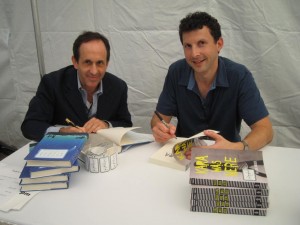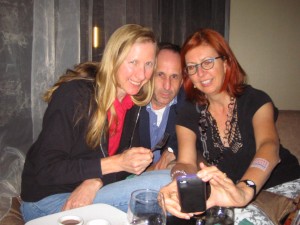Ben Steelman of the Wilmington Star-News (NC) posts an interview with me about “The Night of the Comet,” here. Thanks again, Ben.
From Nut and Honey to “Night of the Comet”
Monday, September 30, 2013 at 5:52 by Ben Steelman
Book lovers will suffer a sweet agony Tuesday night (Oct. 1) — two terrific book events, happening at almost exactly the same time, on different ends of Wilmington.
Over at the Northeast Regional Library, local author Dana Sachs will be doing a program on her latest novel, “The Secret of the Nightingale Palace,” beginning at 6:30 p.m. (Don’t know about Dana? Click here.)
Meanwhile, over at Pomegranate Books, 4418 Park Ave., UNCW alumnus George Bishop Jr. will be giving a reading from HIS new novel, “The Night of the Comet,” at 7:30 p.m.
This is painful, since Sachs and Bishop are friends who earned their MFAs almost at the same time. Sachs, moreover, promotes “Night of th Comet” on her Facebook page. Bishop was originally going to start at 7 p.m., but he’s delaying a bit so that some people can at least peek into both events.
Anyway, it would be good to see Bishop, who now lives in New Orleans and hasn’t been back to town in a while.
This is an intriguing guy. As Beau Bishop, he was a former teen actor, who had guest roles on several TV series (“Fame,” Diff’rent Strokes”) and in a 1988 movie titled “Teen Vamp,” which he now describes as “dismal.” Wendy Brenner of the UNCW creative writing department has been shooting out links to this Kellogg’s Nut and Honey commercial that Bishop did in his younger days. To see it, click here.
Later, Bishop found a new career teaching English as a second language in countries around the world.
Katharine Walton, the Chapel Hill-based literary publicist, interviewed Bishop about his international travels, his acting career and more. Here’s a transcript:
Q: We’re expecting another “Comet of the Century” soon, with Comet ISON heading our way this fall. What’s the expectation for astronomers, or for novelists, for that matter?
George Bishop: Auspicious — definitely! ISON is coming as my book is taking flight, so to speak. Just like Kohoutek, Comet ISON (named after the International Scientific Optical Network observatory) has gotten a lot of people excited. It’s a sun-grazer, which means it’ll sweep awfully close to us. It’s been in the news for months now; astronomers say it’ll be at its brightest between Thanksgiving and Christmas. Of course, there’ve been the usual doomsday predictions and conspiracy theories swirling around ISON: some say it’ll strike the Earth, or that it’s not a comet at all, but the mysterious “Planet X,” or that it’s really three UFOs. I’m just hoping I’ll get a chance to see it. I’ll be on the lookout.
Q: The backdrop of “The Night of the Comet” is the coming of Comet Kohoutek in 1973. For those of us who don’t remember Kohoutek, what made it so special? Why’d you choose it for your novel?
A: Kohoutek was billed as the “Comet of the Century.” Astronomers predicted that it would be bigger than Halley’s, maybe the greatest comet people had ever seen. Although I never saw the comet myself, I remember the tremendous sense of excitement surrounding it. Kohoutek was like the rock star of comets. It was everywhere in the media: on the TV, the covers of magazines, the front pages of newspapers. Songs were written about it, and viewing parties were organized all over the country. Kohoutek was supposed to arrive right at Christmas-time, too, which made it seem especially portentous. Religious fanatics said it signaled the end of the world; they were calling it “The Doomsday Comet” and “The Christmas Monster.”
But then it failed to live up to all the hype — and it really was a spectacular failure. Hardly anybody saw it — it quickly became known as “the Flop of the Century.” Even today, Kohoutek’s thought of as the laughingstock of comets.
As a novelist, the path of Kohoutek suggested an obvious dramatic arc to me, the kind of shape we look for in a good story: that sense of rising expectation, and then the climax (or anti-climax, as the case may be), and the dénouement. Besides, call me a sentimentalist, but I kind of pity the comet. I mean, who wouldn’t? I figured Kohoutek deserved another chance to shine.
Q: Speaking of which, Shelf Awareness noted “The Night of the Comet” might spark a run on telescopes. Do you own one? Do we need one to see this comet — or to read your novel?
A: “The Night of the Comet” isn’t really about astronomy; it’s a novel about relationships, and dreams, and love, set against the backdrop of this oncoming comet. So, no: no knowledge of astronomy required for reading my novel.
I only have an amateur’s appreciation for the stars myself. I didn’t know much about astronomy when I began writing this book, just the usual half-remembered facts from high school. So I enjoyed finally getting to know that part of our world a little better. I read Carl Sagan, and Stephan Hawking and books like “The Amateur Astronomer’s Handbook.” I kept a chart of the constellations tacked to the wall above my desk, and I studied online historic star maps, trying to figure out constellations and moon phases for the year 1973.
I read all about comets, too, of course, and found a couple of fun, sensationalistic books written about comets, one published in 1910 at the time of Halley’s return called “Comet Lore,” and another that came out during the build-up to Comet Kohoutek called, appropriately enough, “Kohoutek!”
I have to confess, though, that I’d still be hard pressed to identify more than a few constellations. And I still don’t own a telescope, although since writing the book I think I’d like to get one now.
Q: It sounds like the comet also functions on a symbolic level in your story. Is that right?
A: In a broad sense, sure. All the members of the Broussard family — the main family in story — are going through some dramatic changes in their lives, and so in a sense, the comet comes to stand for everything they aspire to. Their hopes, their desires. At the same time, the whole country was going through some pretty dramatic changes then, too.
While writing the novel, I came to think of this age of Kohoutek — the early ’70s — as a transformational moment in America’s history. They were the country’s awkward adolescence, you could say, when it was transitioning from the boundless, youthful optimism of the post-war boom years — think of Disney’s Tomorrowland, for example —t o the more sober, complicated years that followed. This was accompanied by the gradual falling-off of a fascination with space exploration and a belief in science as the great hope for the future. A decade later, the tragic Challenger space shuttle disaster pretty much marked an end to that era.
Q: You were an actor in Hollywood before you became a novelist, weren’t you? How does that background influence your writing?
A: The past really does stay with you, doesn’t it? Yes, it’s true, I was an actor for almost a decade in Los Angeles. I did a lot of TV commercials, guest-starring roles on sitcoms, and I was the vampire lead in a somewhat embarrassing B-film called “Teen Vamp.”
I studied acting when I was in Los Angeles, and I believe that’s influenced my writing in how I go about building a character. As an actor, you’ll try to invent a whole biography for a character you’re playing: their childhood, their fears, their hates, their passions. I do the same with my characters in writing. I’ll even act out scenes in my apartment — which probably causes my neighbors some concern. The other thing that I took from acting, especially from studying plays, was an appreciation of good dialogue and scene structure, how to build dramatic tension.
Q: After acting, you worked as a teacher all over the world. Slovakia, Turkey, Indonesia, Azerbaijan, India . . .
A: Japan, too. Right. I taught overseas for almost 12 years.
Q: How does that experience play into your writing?
A: While I was living overseas, I actually wrote two expat novels — you know, Americans abroad. Those novels are still on the shelf. But one thing that went into “The Night of the Comet” from my years overseas was my teaching experience. The main protagonist in the story, Alan Broussard, is a high school science teacher, and so a lot of his feelings and challenges as a teacher come from my own background in the classroom.
Q:. What brought you back to Louisiana for this story?
A: It’s a little surprising even to me that my first two published novels should be set in Louisiana. Maybe it’s because, despite being away for so long, my years in the South really were my formative ones.
Like the narrator in “Comet,” I grew up in a very small town, Jackson, Louisiana. That part of the state, East Feliciana Parish, is more pine country than bayou, but it gave me a feel for the setting of my book. Like the fictional Terrebonne in my novel, my hometown had only a couple of gas stations, a handful of shops, two schools, and a water tower. For a boy, it provided a certain sense of containment and knowability. I could circumnavigate my whole world in a half hour on my bike. Those were the kind of things that found their way into this novel.
For more about George Bishop, click here.













